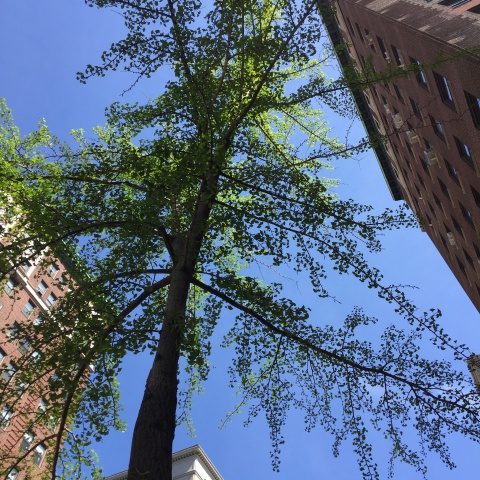Future City Lab: New York's Trees
Interdisciplinary

Time Estimate: 1 hour
Connection with Future City Lab: Living with Nature: How can New York City enhance its natural environment and cope with climate change?
Objectives:
Students will:
- think about how trees function in and benefit the urban ecosystem
- compare and contrast different value metrics
- demonstrate ability to navigate online tools and glean information from them
Materials:
- Presentation (provided)
- Handout (provided)
- Internet-connected computers for student use
- Computer-connected projector for discussion
Standards:
- CCSS.ELA-LITERACY.CCRA.R.7: Integrate and evaluate content presented in diverse media and formats, including visually and quantitatively, as well as in words.
- CCSS.ELA-LITERACY.CCRA.R.10: Read and comprehend complex literary and informational texts independently and proficiently.
- CCSS.ELA-LITERACY.CCRA.L.6: Acquire and use accurately a range of general academic and domain-specific words and phrases sufficient for reading, writing, speaking, and listening at the college and career readiness level; demonstrate independence in gathering vocabulary knowledge when encountering an unknown term important to comprehension or expression.
Guiding Questions:
- How can cities invest in the health of their trees?
- What benefits – tangible and intangible – do trees bring to the urban environment?
- Step 1: Do In Advance
- Step 2: Introduction (15 minutes)
- Step 3: Small Group/Individual Activity (15 minutes)
- Step 4: Class Discussion (20-30 minutes)
Procedures
This lesson is inspired by the Museum’s Future City Lab, in which visitors are encouraged to think about New York City as a community with five distinct challenges that represent where fruitful improvements can be made. The “Living With Nature” challenge addresses sustainable growth and how to adapt to climate change, and encourages visitors to think of street trees as a high-yield investment in New York City’s future. For more on the Future City Lab, see http://www.mcny.org/exhibitions/core/future-city.
(Note: This lesson is best used in a classroom where students can have internet access in groups of 1-4, via either computer or tablet.) Prior to the lesson, familiarize yourself with the New York City Street Tree Map. Pay particular attention to “Benefits of Trees to NYC” to prepare for class discussion.
Using the provided presentation, review the New York City Street Tree Map. Be prepared to talk students through the benefits trees bring to NYC by reviewing the materials in Step 1. (You can use this opportunity to discuss specific concepts that might be covered in relevant science units.) Familiarize students with the tool by doing a preliminary fact-gathering exercise as a class. All answers are on the left-hand dialog box marked “NYC’s Street Trees” – note that you will have to scroll to the bottom in order to get the numbers for the various ecological benefits.
Have students work on the provided worksheet. Students are likely to want to choose their own neighborhood, so decide in advance whether you want to allow student choice or whether to direct them to different neighborhoods for comparison. (If you are outside NYC, you can use the Museum’s address at 1220 Fifth Avenue, Manhattan, as a starting point – zoom out until you can see its neighborhood, “East Harlem South.”)
As a class, discuss:
1.) Which student chose the neighborhood with the most trees? Check for understanding: Is it easy to directly compare neighborhoods regarding tree totals? What other information would we need to know to understand which neighborhoods are the most tree-dense?
2.) Which species were the most common in their respective neighborhoods? Why do we think that might be?
3.) Looking at Part Two, can we figure out which tree with a 12-inch trunk diameter gives us the most “value” (out of the ones we found, at least)? Check for understanding: Why did we control for size in this exercise?
4.) Were there any surprises?
5.) What information is needed to understand trees’ total cost value to New York? (Among other things, the cost of maintaining and planting needs to be factored in.)
6.) What other types of value does this economic analysis leave out? (Students should be able to identify intangible factors like making the city pleasant and aesthetically appealing.)
Optional extension: If the season permits, encourage students to look around them as they walk on the streets and see if they can identify some of the species (good ones to start with are the London Planetree, Thornless Honey Locust, and Ginkgo) they discussed today. Have them take pictures and share with the class.
ADDITIONAL RESOURCES:
Leafsnap – a free mobile app where students can take pictures of trees and identify them, and then play games to test their tree knowledge (available on the iTunes App Store).
“Cure Yourself of Tree Blindness,” Gabriel Popkin, The New York Times, August 26, 2017: a case for knowing more about trees.
“Why Do We Keep Planting Stinky Ginkgos?,” Maureen McMurray and Taylor Quimby, Slate.com, October 10, 2016.
Fieldtrips: This content is inspired by the Future City Lab gallery in the Museum’s flagship exhibition, New York at Its Core. If possible, consider bringing your students on a fieldtrip to see the gallery in action! Visit http://mcny.org/education/field-trips to find out more.
Acknowledgements
This series of lesson plans for New York at Its Core was developed in conjunction with a focus group of New York City public school teachers: Joy Canning, Max Chomet, Vassili Frantzis, Jessica Lam, Patty Ng, and Patricia Schultz.
This project was made possible in part by the Institute of Museum and Library Services.
The views, findings, conclusions or recommendations expressed in these lessons do not necessarily represent those of the Institute of Museum and Library Services.

